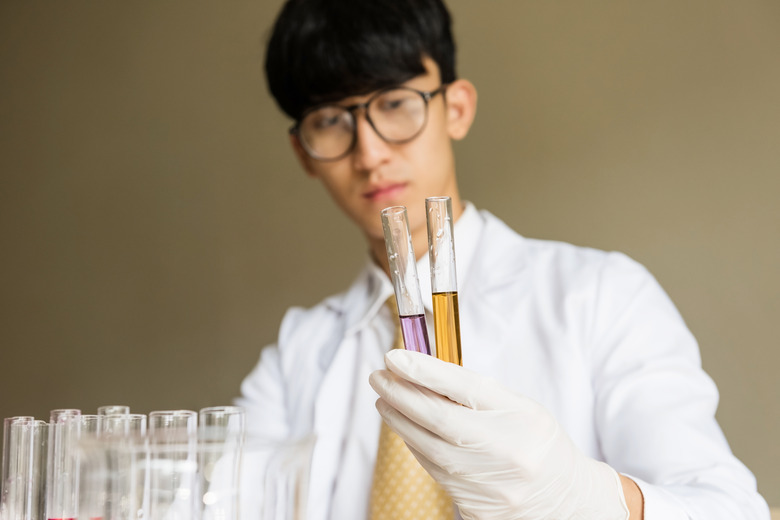What Happens When Chemical Bonds Break And New Bonds Form?
Chemical reactions break existing molecular chemical bonds, and new bonds form as a result. Typical chemical reactions include combustion, reduction and precipitation. During these chemical reactions, the original molecules break apart and form new bonds to produce different materials. Sometimes, it is enough to bring two substances together for a chemical reaction to begin, but often an external stimulus such as heating the substances is required. Each chemical reaction is a complex interaction of molecular attraction, energy levels and external influences.
TL;DR (Too Long; Didn't Read)
Chemical reactions make and break the chemical bonds between molecules, resulting in new materials as the products of the chemical reaction. Chemical reactions can occur spontaneously or require an outside trigger such as an input of energy. Breaking chemical bonds absorbs energy, while making new bonds releases energy, with the overall chemical reaction being endothermic or exothermic.
Chemical Bonds and Energy Levels
Chemical Bonds and Energy Levels
The basis of all chemical reactions is the breaking of bonds, or decomposition, and the creation of bonds, or synthesis. Decomposition requires energy because the chemical bonds are initially stable, and energy is required to break them apart. The molecules in the bond have a lower energy level than free molecules; adding energy allows them to break free.
Synthesis releases energy because the molecules bond to form a stable configuration and therefore give up energy. The bonded molecules have a lower energy level than free molecules and are held in the new bond.
An overall chemical reaction that breaks bonds and forms new ones can be endothermic (absorbing heat) or exothermic (releasing heat), depending on how much energy is absorbed and produced by the decomposition and synthesis reactions. Some reactions produce heat overall, while others either absorb heat from their surroundings or require the addition of outside heat to complete the reaction. Under normal conditions in stable surroundings, a chemical reaction needs an external stimulus to start.
Endothermic Reactions
Endothermic Reactions
Because it takes energy to break chemical bonds and start chemical reactions, few endothermic reactions happen by themselves. The process usually takes an input of energy to start the reaction and to maintain it. Even reactions that are exothermic overall may need an input of energy at the start to break some of the bonds.
Decomposition reactions are simple endothermic reactions and require an input of energy. For example, heating mercury oxide produces mercury and oxygen. Endothermic reactions that are more complicated can take place if they can use heat from their surroundings. For example, the solids barium hydroxide and ammonium chloride react in an endothermic reaction at room temperature to produce barium chloride and ammonia at a much colder temperature. The reaction takes heat from the materials themselves, their container and the ambient air.
Exothermic Reactions
Exothermic Reactions
Reactions that produce an excess of heat overall are more common because they tend to be self-sustaining. Synthesis reactions produce heat, so they don't need an external heat source to proceed. For example, adding a small amount of sodium to water produces sodium hydroxide and hydrogen in an explosive exothermic reaction. The reaction starts spontaneously and continues until one of the reactants is used up. It usually produces so much heat that the hydrogen burns with the oxygen of the air to form water.
Complex reactions that rely on both breaking and forming chemical bonds often need an external energy input to start but are then self-sustaining. For example, the combustion of hydrocarbons requires a heat source to break the first few bonds. Typically, materials containing hydrocarbons, such as wood or fuel oil, need a match or a spark to decompose some of the bonds. Once the formation of new bonds with the production of heat starts, the reaction continues, producing carbon dioxide and water vapor.
Many common industrial and commercial processes rely on chemical reactions, especially exothermic self-sustaining ones. How useful they are and how much work they do depends on the kinds of materials that are reacting and the chemical bonds that are breaking and reforming.
Cite This Article
MLA
Markgraf, Bert. "What Happens When Chemical Bonds Break And New Bonds Form?" sciencing.com, https://www.sciencing.com/what-happens-when-chemical-bonds-break-and-new-bonds-form-13710469/. 23 March 2018.
APA
Markgraf, Bert. (2018, March 23). What Happens When Chemical Bonds Break And New Bonds Form?. sciencing.com. Retrieved from https://www.sciencing.com/what-happens-when-chemical-bonds-break-and-new-bonds-form-13710469/
Chicago
Markgraf, Bert. What Happens When Chemical Bonds Break And New Bonds Form? last modified August 30, 2022. https://www.sciencing.com/what-happens-when-chemical-bonds-break-and-new-bonds-form-13710469/
